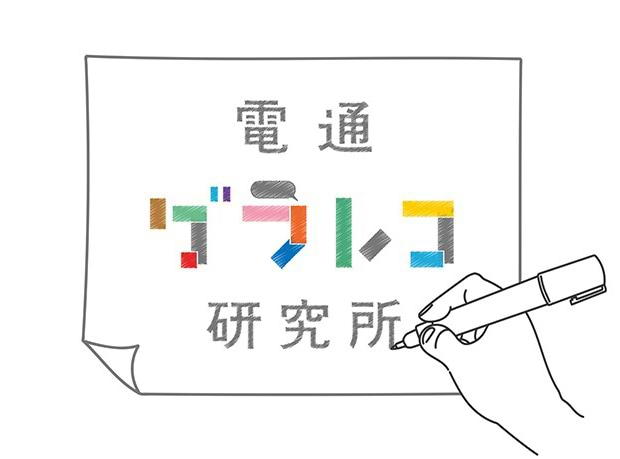Spanning various divisions of the dentsu Group, Mirai Jigyo Soken—literally “future business creation research”—is an organization that helps companies create businesses and spark innovation by envisioning their future.
Rather than taking a problem-solving approach, it starts with a vision of ideal circumstances and then devises ways of achieving such a future. Based on this vision-driven approach, last September members of Mirai Jigyo Soken held Sanin Mirai Classroom 2023 workshops for 116 junior high school students in Shimane Prefecture. This gave the students an opportunity to envision an exciting future for Shimane.
The workshops were held jointly with San-in Chuo Shimpo, a news organization covering Shimane and Tottori prefectures, and a junior high school affiliated with Shimane University’s Faculty of Education. Designed for students in the second year of the junior high school, the workshops were part of a course about creating the future. It also explored ideas for making Shimane number one in Japan, and an attractive place people would want to visit and where they would wish to live.
Original ideas were presented not only by the students, but also by numerous community leaders, including Akihito Uesada, the mayor of Matsue city; Kenshi Nonomura, president of Toyota Corolla Shimane Co., Ltd.; and Masahiro Hiraishi, representative director of Monstar Lab Omnibus, Inc.
About Mirai Jigyo Soken
As an inter-divisional organization of the dentsu Group, it supports initiatives by companies to create businesses and spark innovation by envisioning their future.
The enterprise seeks to create communities that inspire their youth to look forward to the future. It works with corporate clients to picture an ideal tomorrow, and helps them take the initial steps toward realizing such a future.
Website (Japanese language only): https://dentsumirai.com/
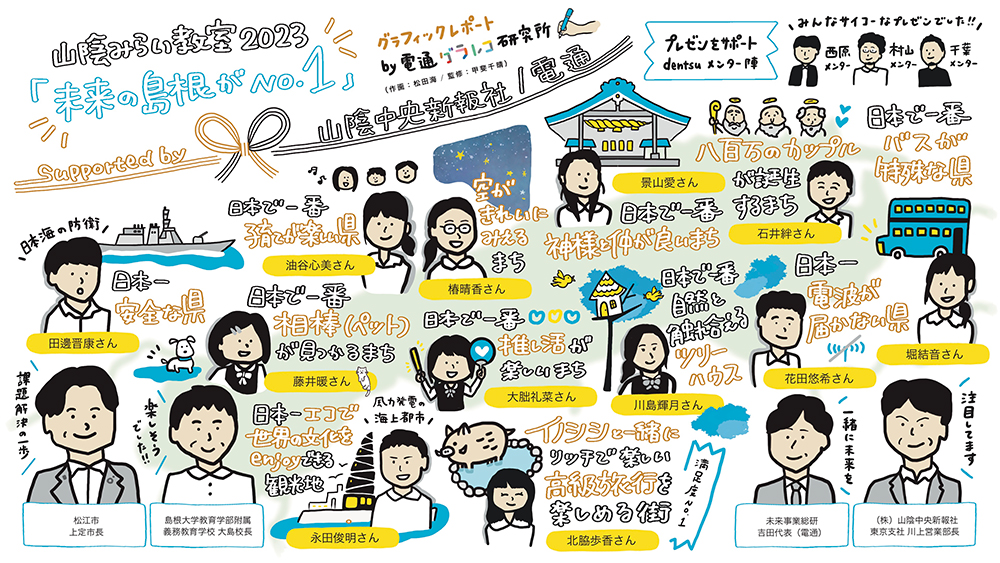
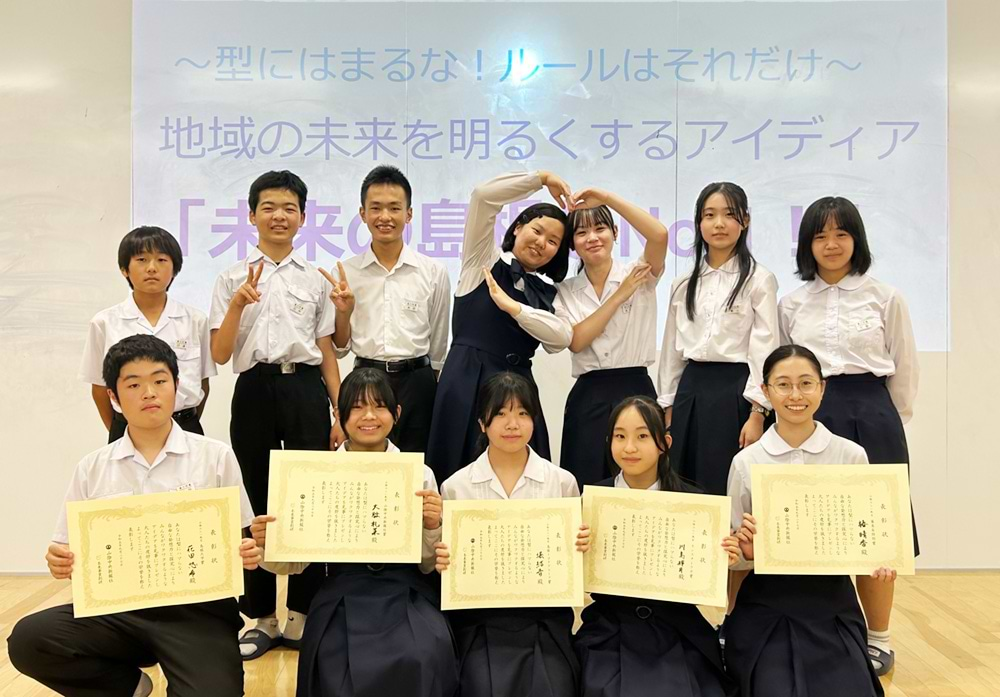
Junior high students imagine a negative future full of problems
Japan’s declining population is a major issue facing the entire country. Yet that and the aging population are even more serious in relatively rural prefectures such as Shimane.
Aware of these and other issues, especially those related to the environment and energy, junior high school students in Japan tend to imagine a future of ongoing problems and anxiety. It is difficult for young people to get excited about a future focused merely on problem solving in order to reduce negative outcomes.
In contrast, a vision-driven approach will start with imagining positive aspects of the future. Things that people can look forward to and that make them feel happy then can be linked to relevant issues.
Next were considered matters that need to be solved if the desired future is to be realized. However, so as to attain our original goal of imagining a fun future, we were careful at the workshops not to emphasize solving problems, or to link the future we envisioned to problems.
We welcomed the aspirations and ideas expressed by the students, and had them imagine a future to which they could look forward and about which they could be happy.
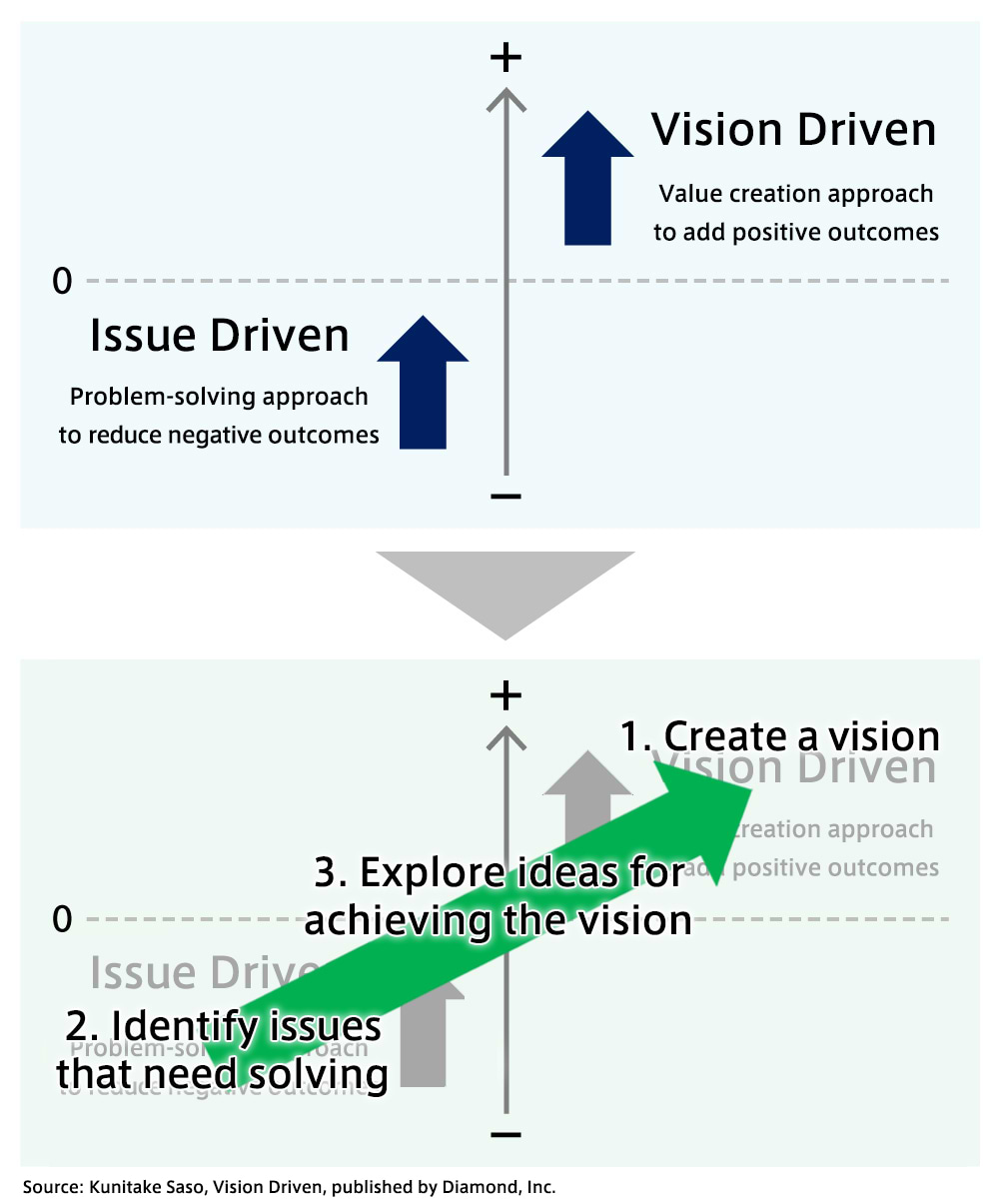
Hard-to-imagine, exciting future for Shimane
Students came up with 116 ideas during the day’s workshop. Although I truly wish I could present all the ideas here, I have selected 12 due to space limitations.
The first idea, from Haruka Tsubaki, was “a place with a clear view of the sky.” Selected for a special judges’ prize, her outstanding presentation offered a balance between the typical lifestyles of Shimane and environmental contributions.
Rather than simply pointing out how clean air makes a starry sky beautiful at night, she proposed ways to make the sky look even clearer. One way suggested would be to reduce the use of electricity at night by adopting the healthy habit of going to sleep and waking up earlier.
She also suggested moving utility pole wiring and other equipment underground, while making good use of infrastructure already in place. I found it a really vision-driven presentation.

Next, Kizuki Kawashima proposed building “Japan’s best treehouses for connecting with nature.” One of the great things about Shimane is its abundance of nature, so the best treehouses in the country could serve as places for truly appreciating it.
She also suggested building these treehouses using scrap wood from abandoned homes as a way of addressing the problem of uninhabited properties. These have been increasing in number due to the declining population.
“Japan’s top prefecture for unusual buses” was an idea presented by Yune Hori. Rather than having the most or the fastest buses, her idea pointed to buses that are uncommon. In the future, Shimane could become a gathering point for such buses, as well as for different buses from around the world. She also imagined Shimane becoming hallowed ground for bus lovers.
Reina Otsuki imagined Shimane as “Japan’s most enjoyable place for people to promote their favorite artists and things.” By welcoming such fans, creating retail and event spaces for regular activities, along with other initiatives for providing a positive environment in every city, she envisioned a future when artists and performers would start their tours and events from the local city of Matsue.
Haruki Hanada proposed making Shimane “the only place in Japan with no mobile phone signals.” A lack of mobile phone signals has been seen as a problem in the past but, on the contrary, his idea pointed to the benefits.
Given that people are so dependent on smart phones and the internet, by cutting off these signals Shimane could be a place where people can improve their natural senses, fully appreciate nature, and gain new awareness. Personally, his proposal made me want to visit such a place immediately.
The five ideas above were selected for awards during the day’s workshop. The following seven ideas were also considered outstanding.
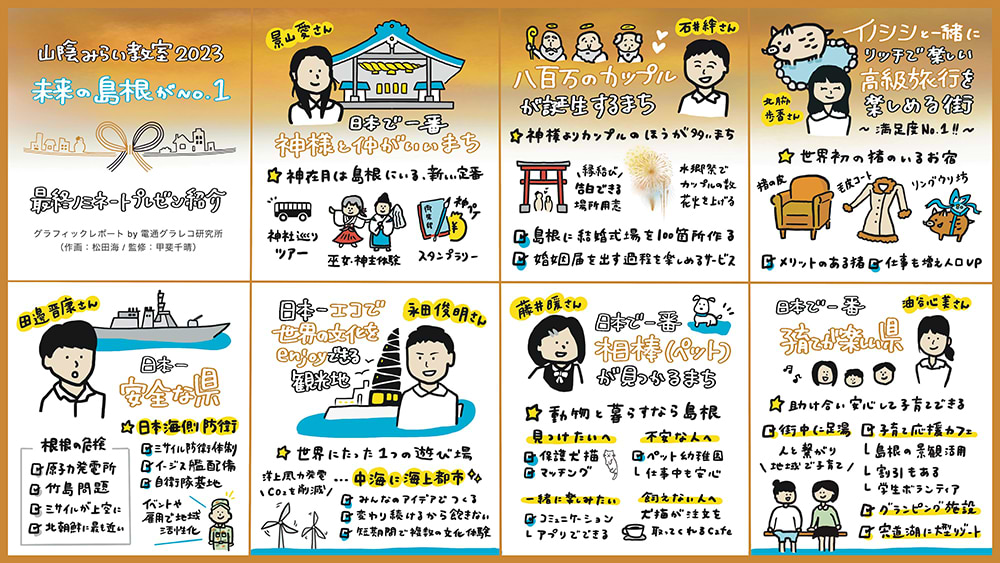
In a presentation on making Shimane “the safest prefecture in Japan,” Tanabe Shinya showed his strong interest in military affairs and national defense.
He had thoroughly studied this topic and even used terminology with which we were not familiar. His presentation opened our eyes to how safety is created by people and cannot be secured if we don’t play an active role.
Ai Kageyama gave a presentation on making Shimane “Japan’s prefecture closest to the gods.” Indeed, legend has it that countless gods from all over the country gather for a meeting at the prefecture’s Izumo Temple in October.
Moreover, in Shimane the word for the tenth month of the lunar calendar is not written the same as in the rest of Japan. I find the idea of being close to the gods wonderful. It seems to bring happiness, and I have felt good vibes among the people in the area.
In connection with this divine theme, making Shimane a place for “creating countless romantic bonds” was an idea proposed by Kizuna Ishii. He suggested building a hundred wedding halls in Shimane, matching the number of couples with the number of fireworks launched at events, and offering fun services at the time of marriage registration.
He also had many ideas for making the search for marriage and romantic partners more enjoyable.
The most humorous presentation of the day was by Ayuka Kitawaki. Her idea was to have “a place where people can enjoy enriching, fun, and high-class vacations with wild boars.” She suggested creating the world’s first hotel that allows guests to touch and spend time with wild boars.
In addition, furniture and fur coats made with wild boar hide could be sold at the hotel, and weddings held there could feature a wild boar piglet as the ring bearer. Her spotlight on wild boars was an unexpected and very amusing idea.
Toshiaki Nagata spoke of his big aspiration to make Shimane “Japan’s top eco-friendly tourist destination for experiencing world cultures.” Considering the lack of amusement parks in Shimane, he regarded the creation of places that can attract visitors as an important mission. The scope of his idea, however, was very broad, as he described a really exciting plan to create an urban island in the middle of Lake Nakaumi.
Non Fujii presented an idea for “Japan’s best place to find a pet.” Pointing out that pets should also have a happy future, she spoke tenderly about the issue of dogs and cats kept in shelters, and ways of improving the lives of pets that are left alone when their owners are at work.
Finally, Kokomi Aburatani talked about making Shimane “the most enjoyable prefecture in Japan for raising children.” Her idea was about providing support for families, creating places where people can form relationships, as well as having places where parents and children can play. I felt that if her idea could be realized, raising kids would certainly be a lot more enjoyable.
Paths to an exciting future
The students came up with these interesting ideas on their own. But having their ideas accepted by the adults connected to the workshop was important for facilitating the process.
We had also adopted this basic approach in workshops on “vocational schools of the future.” They were conducted for 14-year-old students at Midorinogakuen Compulsory Education School, a public junior high school in the city of Tsukuba, Ibaraki Prefecture.
Adults involved in those workshops were completely open to the ideas presented by the students. This encouraged the students to open up about things they generally kept to themselves or found hard to express. They were also able to offer opinions that they would normally hesitate to give, fearing that people might regard them as impossible or of less importance than more practical solutions. Moreover, the approach of the adults motivated them to think through their ideas.
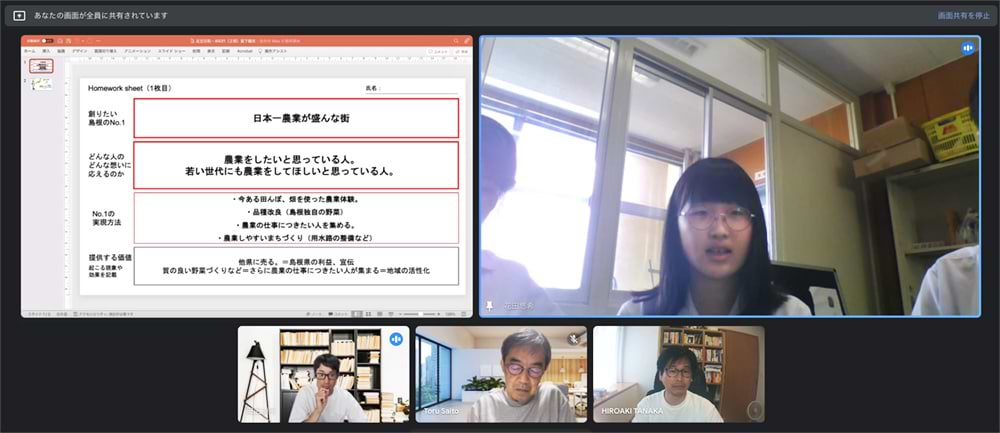
The students in the second year of the junior high school are at a stage between childhood and adulthood, and have personal opinions that might be quickly dismissed by many adults, even if those adults are of the same opinion.
Yet such personal opinions will spread quickly if adults are open to them. That was very obvious to me when I participated in the workshops about future vocational schools that were held for 14-year-old students.
The students from Shimane who took part in those workshops are also aware of the issues facing their prefecture, and are thinking about what solutions might be needed. For that very reason, rather than focusing on problem-solving, we encouraged them to freely imagine an ideal future and the steps by which this might be realized, including the tackling of issues.
Adults, having broader life experiences, are aware of the risks and difficulties involved in getting things done. In reality, though, most ideas are not impossible to achieve. Although doing so might be difficult, we shouldn’t assume that suggestions are not feasible. With that in mind, it is certainly worth considering both the ideas of the junior high school students and the future they envision.
Can one help create a vision for the future?
Before holding the 2023 workshops in Shimane, we had the students fill out a questionnaire. Among all of the respondents, less than one-third expressed a desire to help revitalize Shimane in the future. I think this reflects the situation in many of Japan’s rural regions. There, most young people aspire to moving to big cities to pursue their interests. That is not a bad thing, of course. While regional revitalization is important for Japan, at the same time it is splendid that individuals have goals and pursuits while working towards their future.
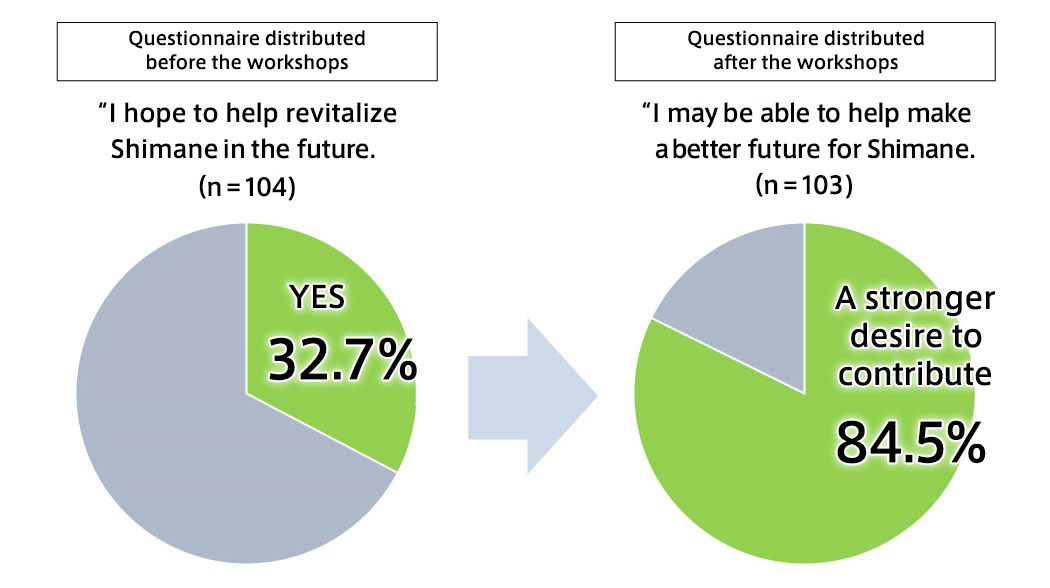
In the post-workshop questionnaire, the students responded more positively, with 82.3% agreeing with the statement, “I may be able to help make a better future for Shimane.”
While the percentage of students who expressed a desire to live and work in Shimane did not change significantly from the first to the second questionnaire, I was happy to see the strong desire to contribute to Shimane’s future. Perhaps, as a result of the workshops, the students became more aware of the many possible ways they could help make a better future for Shimane, even if they do not work or live there.
I also believe that the students gained confidence by thinking about concrete ideas and having those ideas accepted. The students went from wondering how they could contribute, and feeling unsure about how to make Shimane a better place, to watching each other present over a hundred ideas. This allowed them to clearly imagine what might be done. It also gave them important opportunities to relate to certain ideas, imagine what is possible, and consider what they want to do.
Toward a better future for the next generation
Young people will play central roles in the future, so I believe that we adults should support students’ ideas and aspirations. To do so, it is important to be receptive to their ideas and aspirations from the start. Then one can think of ways to improve the ideas together, rather than to judge whether or not the proposals are realistic.
When young people and students tell us about their big ideas, we tend to encourage them to be more practical and realistic. If, instead, we were to take the standpoint of improving on their ideas, we could prompt them to find possible ways to achieve what they previously thought was impossible. Or they might come up with new ideas that are even better than their original ones.
I am confident that the experience of this approach can open up opportunities for individuals to recognize the importance of having a vision, and then to consider what might be done to create an ideal future.
Because we would like young people from many regional communities to experience such an approach, we hope to form partnerships and expand our activities. I invite all those who are interested to contact us. Together, we can inspire more and more young people to create a bright future.
Graphic recording and reporting partner
Dentsu Grareco Lab (illustrator: Marin Matsuda; production supervisor: Chiharu Kai)
A project team with members from across the dentsu Group, the Dentsu Grareco Lab was set up to conduct research and provide visualization services, particularly graphic recording.
Webpage (Japanese language only):
https://www.dentsu.co.jp/labo/grareco/index.html
